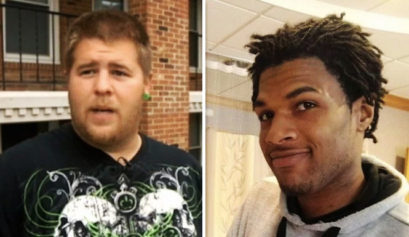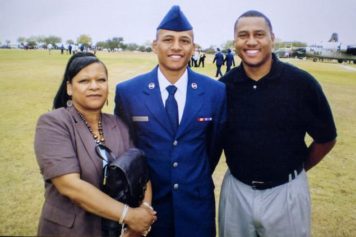Just two weeks before officers shot and killed John Crawford III inside an Ohio Wal-Mart, they received a training presentation that encouraged them to immediately engage a would-be gunman with “speed, surprise and aggressiveness” and to consider that a loved one was trapped in the building when deciding whether to wait outside for backup or “enter the building and find the threat as fast as possible.”
The pep talk and slide show presentation was presented to Officer Sean Williams and his colleagues just 12 days before Williams killed Crawford at the Wal-Mart. The officers were summoned to the scene by a 911 call from Ronald Ritchie, who later admitted that he embellished the call when he repeatedly said that Crawford was pointing a gun at Wal-Mart customers, including children. But based on the surveillance footage from the Wal-Mart released Thursday, Crawford casually walked past shoppers at the store with a toy air rifle that is sold at Wal-Mart.
The officers were being trained how to respond to “active shooter situations” such as the ones that occurred at Sandy Hook Elementary School in Connecticut or Columbine in Colorado.
“If not you, then who?” officers were asked during the presentation while they saw a photograph of young students being led out of Sandy Hook elementary school in December 2012. According to a story in The Guardian, the officers read a caption reminding them that 20 children and five adults were killed before police arrived.
Special prosecutor Mark Piepmeier released the slide presentation to the public, after using it as evidence presented to the grand jury in Greene County. On Wednesday, the grand jury decided not to indict officer Williams on criminal charges for killing Crawford.
“A question I have, and I think a jury would have, is how are the officers trained to deal with a situation like that,” Piepmeier told reporters, describing the presentation as “almost like a pep talk for police officers.”
Piepmeier said before the Columbine shooting in 1999, police were trained to secure and evacuate the scene of a potential shooting and then wait for a SWAT team.
“The FBI realized that wasn’t working, because in that five or 10 minutes they were waiting for people to arrive, people were dying,” he said.
Officers are now trained to enter the scene even if they arrive alone.
They are told that the average incident involving a “terroristic threat or an active shooter” will last three to four minutes and “every 15 seconds, someone is going to be shot,” Piepmeier said.
Less than five minutes after Ritchie’s 911 call, Crawford was shot by Williams.
Piepmeier said that one of the officers even called back to confirm that Crawford was pointing the rifle at people.
Piepmeier said the question is whether an officer is justified in using deadly force to defend himself or others “from what is reasonably believed to be an imminent threat of serious physical harm or death.”
“And that was, really, the question for this jury,” said the special prosecutor. “Looking at everything, was the officer reasonable in thinking that either himself or someone else was going to receive death or serious bodily harm.”
As pointed out by The Guardian, about 80 seconds before Crawford was shot dead by the police officer, Ritchie told the dispatcher: “He just pointed it at, like, two children.”
But that was clearly an exaggeration because the surveillance footage shows Crawford standing still with the rifle at his side as the children and their mother browsed further down the aisle.
After another 40 seconds, the dispatcher asked Ritchie: “You said he pointed it at a couple of kids?”
Ritchie said, “Right.”


